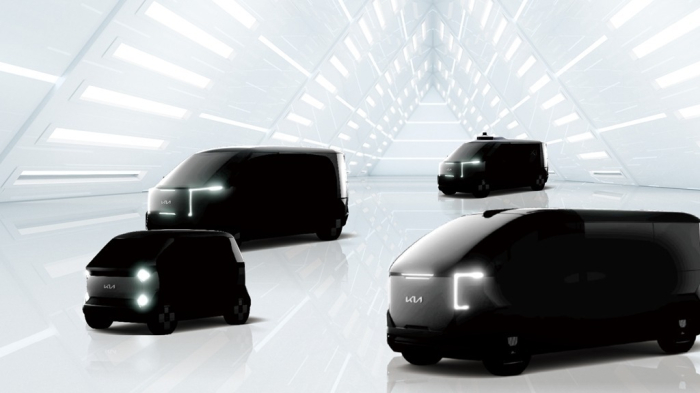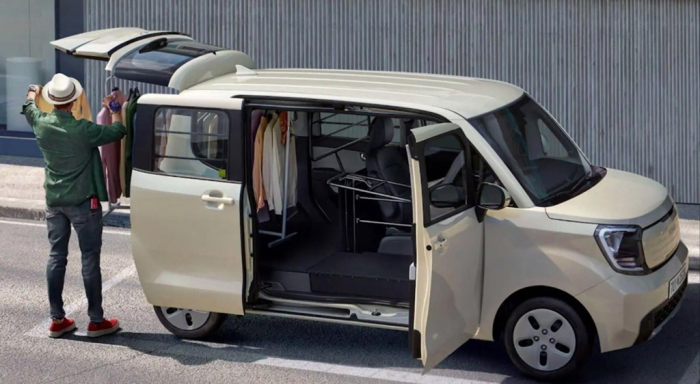Electric vehicles
Kia to build 2nd purpose-built vehicle plant in Korea
Unionized workers are protesting the project as the company does not guarantee job security; wage talks fail
By Oct 13, 2023 (Gmt+09:00)
3
Min read
Most Read
LG Chem to sell water filter business to Glenwood PE for $692 million


KT&G eyes overseas M&A after rejecting activist fund's offer


Kyobo Life poised to buy Japan’s SBI Group-owned savings bank


StockX in merger talks with Naver’s online reseller Kream


Meritz backs half of ex-manager’s $210 mn hedge fund



Kia Corp., South Korea’s second-largest automaker, plans to build another purpose-built vehicle (PBV) factory in the country, despite the risk of disruption by unionized workers, as it aims to take the throne of the emerging custom-tailored car segment by 2030.
Kia, an automaking unit of Hyundai Motor Group, proposed a plan to establish a new plant for large PBVs as a measure to improve competitiveness for future business in wage talks with its unionized workers, according to industry sources on Friday.
The maker of the EV6 and the EV9 electric vehicles is poised to set up the facility at its production complex in Hwaseong, 80 kilometers (50 miles) southwest of Seoul, with a target of mass production of large electric PBVs, codenamed LW, from 2028.
Large PBVs are emerging as the most suitable solution for future mobility amid autonomous driving and smart urban environments because they can be used for various purposes such as multi-seater shuttles or mobile offices, or for cargo delivery.
AMBITION IN PBV SECTOR
Kia, which is leading the group’s PBV projects, already broke ground on its first PBV factory at the complex in April with an investment of 1 trillion won ($741.6 million). The company aims to produce up to 150,000 units of a mid-sized model codenamed SW a year from the second half of 2025 at the plant, the world’s first dedicated facility for PBVs and South Korea’s first factory only for EVs.
The carmaker decided to build another factory as it sees PBVs as a key driver of its future business. General Motors Co., the leading US automaker, has already been selling PVBs to global major logistics company FedEx Corp. and American retail giant Walmart Inc. Japanese automaker Toyota Motor Corp. and US EV producer Rivian Automotive Inc. have also made inroads into the PBV market.

Kia aims to top the segment in the world by selling more than 1.5 million PBVs by 2030. It plans to establish a full PBV lineup ranging from small models to large ones while customizing them to meet various needs.
“The company needs to secure production capacity first in order to dominate the market earlier than others,” said an industry source. “It may have decided on the bold investment, which exceeded market expectations, as it already secured customers in the logistics sectors such as Coupang and CJ Logistics.”
Kia last year signed business agreements with them to build custom-tailored vehicles for product delivery.
RISKS FROM UNIONIZED WORKERS
Kia needs to agree with unionized workers to build the second PBV plant, however.
Unionized employees protested the project as it did not guarantee their job security, saying the company decided to construct the factory at a site for a material plant, not on idle land, and as the company has mentioned outsourcing plans.
The company had to delay the construction of the first PBV facility by about one year as it could not agree with the unionized workers on the production capacity, number of employees and level of outsourcing.
The union and the company also failed to come to agreement during their wage negotiations. The unionized workers are set to stage a partial strike from Oct. 17 unless the two parties reach a last-minute deal.
“The collapse of the wage talks does not necessarily mean that the company cannot build the new plant,” said another industry source. “But we are worried about major disruptions to the urgent future mobility strategy.”
Write to Nan-Sae Bin and Il-Gue Kim at binthere@hankyung.com
Jongwoo Cheon edited this article.
More to Read
-
 Electric vehiclesHyundai Motor eyes purpose-built vehicle market entry
Electric vehiclesHyundai Motor eyes purpose-built vehicle market entrySep 15, 2023 (Gmt+09:00)
2 Min read -
 AutomobilesHyundai to spend $18 bn on EVs; Kia breaks ground on first PBV plant
AutomobilesHyundai to spend $18 bn on EVs; Kia breaks ground on first PBV plantApr 11, 2023 (Gmt+09:00)
3 Min read -
 AutomobilesKia chooses Coupang as first partner for purpose-built vehicle rollout
AutomobilesKia chooses Coupang as first partner for purpose-built vehicle rolloutApr 15, 2022 (Gmt+09:00)
2 Min read -
 Future mobilityKia plans new Korea plant first time in 25 years for purpose-built vehicles
Future mobilityKia plans new Korea plant first time in 25 years for purpose-built vehiclesMar 24, 2022 (Gmt+09:00)
3 Min read -
 Chief ExecutivesKia aims to become purpose-built vehicle market leader: CEO
Chief ExecutivesKia aims to become purpose-built vehicle market leader: CEOFeb 02, 2021 (Gmt+09:00)
4 Min read
Comment 0
LOG IN


